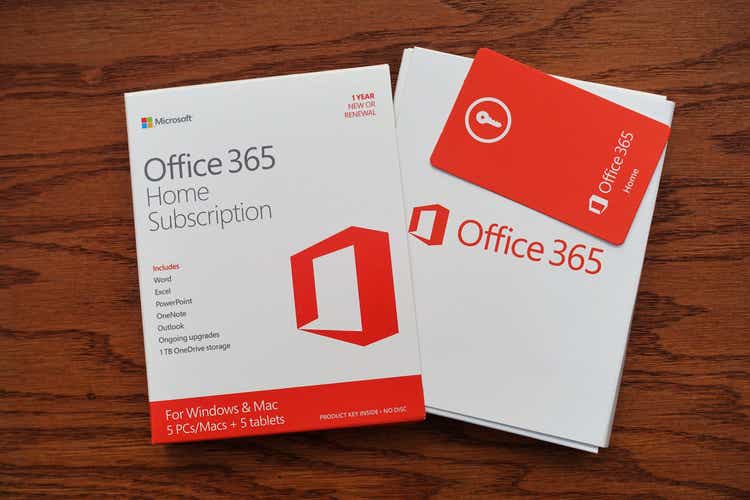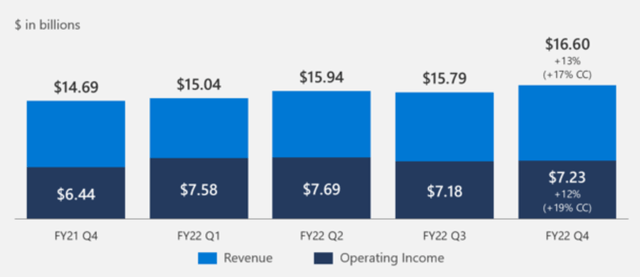NoDerog
Introduction
In this article, I would like to start with a recent announcement that Microsoft (NASDAQ:MSFT) made and then show how, even though it may be of little relevance, it offers once again the opportunity to understand how Microsoft runs its business and, most important, defends its wide moat.
I really enjoy carrying out this kind of research, especially when I have to deal with a very large company such as Microsoft. In fact, I think that very often, understanding well how one particular choice works, enables me to get a grasp of the whole company better than if I were to analyze only its financials without diving into some of its operations.
Microsoft Designer
Let’s get to the announcement: Microsoft is launching Microsoft Designer, a graphic design app in Microsoft 365 that helps users create social media posts, invitations, digital postcards, graphics, and more, all in a flash. The most important feature is that Microsoft Designer is powered by AI technology, including DALL∙E 2 by OpenAI, which enables to instantly generate a variety of designs with minimal effort. From the previews that have been released, it is a very impressive technology that enables to create any kind of image, empowering almost anyone to be a creator. It seems like in almost no time, many users will be able to build cards and social media posts from scratch, without having to search through pre-made templates. It is enough for someone to type in a brief description of the desired image and the AI software creates it. Not only AI builds new images from very simple inputs, but every surface of the app is powered by AI to help ensure consistent, aligned, properly scaled, and beautiful designs, even with or without any inherent design ability.
Now, Microsoft Designer, together with two other products called Created and Image Creator, will be a key element of a family of Microsoft Creator tools. These tools will be part of Microsoft 365 and they will be integrated with Bing and Microsoft’s Edge browser.
The cost to the user? You can guess it: it’s free. Or, said in a better way, it is available for free to Microsoft 365 subscribers. There will also be a premium version for those with Microsoft 365 Personal and Microsoft 365 Family subscriptions.
Why Microsoft Designer Is A Big Deal
So far, many could just think Microsoft is launching some cool apps. But why is this news worthy of attention from investors?
The answer is simple: Microsoft is protecting its moat from the Australian start-up Canva.
Although it is very popular, let’s spend two words on Canva to understand the threat it poised to Microsoft’s core products PowerPoint and Word.
Launched in 2012, Canva is an online design software that puts design and visual communication into the hands of anyone, anywhere, on any device. It lures in subscribers with a free tier, but it then aims to convert them to an individual pro level for $12.99 monthly. There is also the option to activate a team subscription of up to 5 people for the same price. Any additional member added to the team has then to pay an extra $7 per month. Currently, Canva counts 5 million pro customers. Not only this, unlike other start-up companies, Canva is profitable and, it reached $1 billion in revenue last year, twice as much as its 2020 revenue. In 2018, it was valued around $1 billion. When it raised money in 2019 the valuation came around $2.5 billion, which increased in 2020 to $6 billion. Last year, we witnessed a major boost that made Canva’s valuation soar to around $40 billion.
However, as of July 2022, it seems Canva’s valuation dropped 36%, reducing its total value from $40 billion to $26 billion.
Just a few days ago, Canva announced it reached 100 million monthly active users, 10 times as much as it had just five years ago. Among its major customers, Canva sees companies such as Marriott, PayPal, Salesforce, American Airlines, and Zoom.
But it recently made a move that may seem a bit too bold: it challenged Microsoft Word by launching Canva Docs.
Although the company says that it is not competing with Microsoft but with Adobe, it is clear that Canva crossed a dangerous threshold that, in my opinion, Microsoft can’t tolerate.
“Do more with less”
Satya Nadella, Microsoft CEO, has stated it more than once that Microsoft’s imperative is to help people and companies “do more with less”. In other words, Microsoft aims at offering everything a company needs in terms of productivity software. Clearly, a subscribing company has to receive from Microsoft everything it needs (this is the “do more” part) so that it doesn’t have to turn to other companies to complete its range of productivity products (this is the “with less”). We could state the imperative in another way: “Microsoft wants a company to do everything with its products so that it doesn’t do anything with any possible competitor”.
Microsoft 365 Consumer has grown to almost 60 million subscribers. This is where the subscription revenue that Microsoft has come from. Just in the past quarter, the revenue from Productivity and Business Processes was $16.6 billion. This result was driven by Office 365 Commercial, whose revenue growth was 15% YoY. In the past year alone, this line of business generated $63.4 billion in revenue, with a trend that quarter after quarter moves north.
As we have said, Canva has approximately 5 million pro subscribers. If it starts to offer a true alternative not only to PowerPoint but also to Word, then it could actually start taking away some subscribers from Microsoft.
On the other hand, if Microsoft is able to offer some kind of product that not necessarily has to be superior to Canva, but at least somewhat similar to it, then Microsoft subscribers won’t have any reason to move away from it.
This is the strength of Microsoft bundle. In order to protect its core products and its ever-so-precious subscription revenue, Microsoft offers for free with it more and more products to prevent any kind of churn. It may seem at first an expense, but it is actually an investment that protects a huge moat. From this moat comes pricing power, which will allow Microsoft to earn back in future years whatever it had to spend now in order to build Designer.
So, if we try to give a valuation to what Microsoft is doing, we could consider these things. I am pretty sure that if we assume that Canva’s 5 million subscribers also have a Microsoft 365 subscription, we are not far from the truth. Hence, I think Microsoft is defending itself, first and foremost, from seeing some of these Canva pro users move away from Microsoft 365. It means that Microsoft is protecting around 8.3% of its 60 million subscribers, which probably accounts for a quarterly revenue of $1.38 billion. If we look at FY2022 results, we see that Office products and cloud services reached $44.86 billion of revenue, the second-largest source of Microsoft’s revenue after Server products and cloud services. We also know that Microsoft’s profitability reaches a net income margin of 36.7% and that Microsoft’s cash conversion ratio calculated as free cash flow over net income is around 69%.
This means that Microsoft is protecting a net income of around $16.5 billion that generates a free cash flow of $11.4 billion, which is around 22% of Microsoft’s current free cash flow. We are talking about a substantial chunk of Microsoft’s financials.
Conclusion
As a long-term Microsoft shareholder, I was actually becoming a bit worried about Canva and the announcement of Designer, besides intriguing me as a user, has also reassured me as an investor that Microsoft won’t let anyone steal away from it the huge advantage in productivity software. I will look careful at the upcoming earnings call to see if the company will give further updates regarding this new release and to see if any new numbers are disclosed that could make us all realize even better the kind of investment Microsoft is undertaking.



Be the first to comment